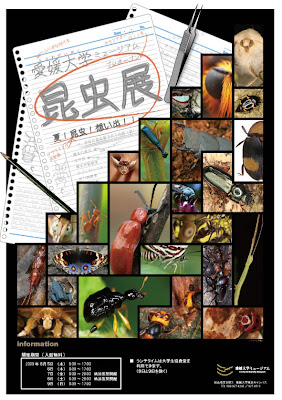At MSP, a lot of what we do is teach kids activity-focused language to enable them to talk about their lives and the things they do in English, but we’re still essentially a school for learning English.
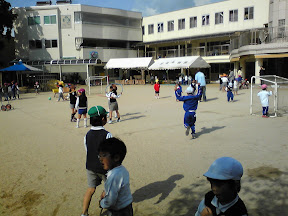 Japanese kindergartens (yochien) are very different than American kindergartens. For one (as far as I can tell), they’re separate institutions of learning, not attached to elementary schools. Also, the large classes don’t seem to be tightly organized. The kids are much freer to do as they please as opposed to older Japanese schoolchildren.
Japanese kindergartens (yochien) are very different than American kindergartens. For one (as far as I can tell), they’re separate institutions of learning, not attached to elementary schools. Also, the large classes don’t seem to be tightly organized. The kids are much freer to do as they please as opposed to older Japanese schoolchildren.
The theory is that the kids have to be free to find their role in the group, then push themselves to fit into it, rather than having an authoritarian teacher or school administrator (or parent) push you into following the rules. As a teacher, I’ll certainly grant that allowing kids to self-correct is often more effective than correcting them yourself whenever they make a mistake.
Anyway, in order to give our students the best of both worlds (the yochien-style “Lord of the Flies” experience as well as the small class size and personal attention we offer at MSP), we take some of our students on field trips to a local kindergarten about once a month.
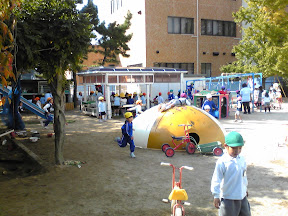 My first time there was absolutely terrifying. I didn’t really know anything about Japanese kindergartens, and I was expecting row upon row of cute little smiling faces greeting the group of visiting kids, which I would enthrall with my English-teaching skillz. That was the plan, anyway.
My first time there was absolutely terrifying. I didn’t really know anything about Japanese kindergartens, and I was expecting row upon row of cute little smiling faces greeting the group of visiting kids, which I would enthrall with my English-teaching skillz. That was the plan, anyway.
We always show up at recess, when the entire student body is free to do whatever they please. They literally have free rein inside the school’s fence, with some kids running around inside the various classrooms gluing milk cartons and cardboard together, but most of the kids outside, doing educational things like using real knives to cut up real vegetables and put in real frying pans on real gas burners (no gas, of course, that wouldn’t be safe). Or jumping on top of a two meter tall jungle gym. Or practicing their unicycle skills (I kid you not).
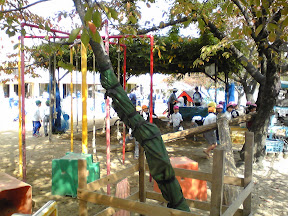 Immediately after we arrive, we put our stuff down in the classroom where we’ll be teaching, and head back outside to make some friends.
Immediately after we arrive, we put our stuff down in the classroom where we’ll be teaching, and head back outside to make some friends.
Playing with the kids is actually pretty cool. Once you realize that nothing either of you says is intelligible to the other, communication becomes all gesticulation and body language. But really, you’re not engaging in intellectual discourse, you’re a walking novelty on a kindergarten playground, so it’s fine.
After recess is over, it’s showtime. This is when the MSP teachers give a thirty-minute lesson to the kindergarten kids. As I think back, I believe there are about 30-35 kids in a classroom, and I always disperse the MSP kids throughout the room. They make good plants, so there are always at least a few voices answering your questions. 😉
 We’ve done lessons for Halloween, Christmas (there’s a whole other topic), animals, and most recently, things in the room. My lessons usually involve the kids smiling and shouting at the top of their lungs, then (sort of) singing a song involving the vocab they just heard, and maybe a little pointing or item identification game or something. Good times.
We’ve done lessons for Halloween, Christmas (there’s a whole other topic), animals, and most recently, things in the room. My lessons usually involve the kids smiling and shouting at the top of their lungs, then (sort of) singing a song involving the vocab they just heard, and maybe a little pointing or item identification game or something. Good times.
What prompted me to write this already-too-long-for-itself entry is the field trip we took last week. It was the first time I felt really comfortable wading into the sea of black-haired ankle-biters. I knew the drill, I knew where we needed to go and when, I seemed like I finally looked like a figure of authority for these kids I’d never seen before.
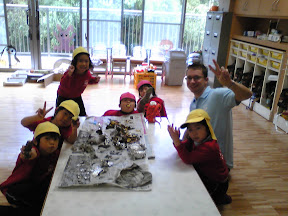 After recess, we had our lesson, and the kids all responded fantastically. They paid attention, they repeated, they pointed, and they shouted on cue. After the lesson, four separate kids came up to me to ask me to sit at their lunch table.
After recess, we had our lesson, and the kids all responded fantastically. They paid attention, they repeated, they pointed, and they shouted on cue. After the lesson, four separate kids came up to me to ask me to sit at their lunch table.
After eating, I sat down on the tatami mat by the bookcase and talked to the small-but-growing group of kids about what I saw in their Japanese books. They pointed at stuff and said things in Japanese. I picked up what I could, but their Japanese was still better than mine, so I mostly ended up smiling, nodding, and saying the thing in English (which is what they wanted most of the time, anyway).
I feel like I’m finally getting the hang of this. 🙂
<a href=”http://picasaweb.google.com/lh/photo/VcpKxc-wP-jisqhN8EDLNA?feat=embedwebsite”><img src=”http://lh5.ggpht.com/_tPVAWD6nVDQ/S_Xz84OUBfI/AAAAAAAAEQ4/h37VdKy6YFU/s288/SBSH0240.JPG” /></a>
Just in case you thought you ate a lot of rice, here’s a picture of the bag of rice we have in our apartment. It’s a 30 kg bag (66 lb).

